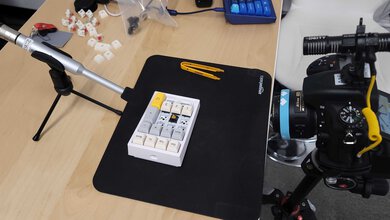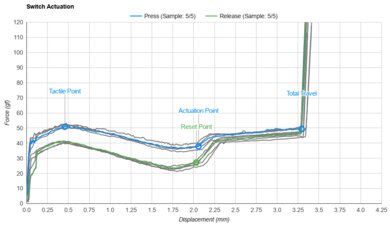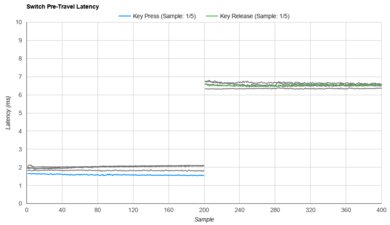
Choosing the best keyboard switches boils down to your needs and preferences. There isn't a 'best keyboard switch' for all people and all situations. We've tested 101 switches and narrowed down nine recommendations for different switch feelings, different price points, and different uses.
If you're new to the hobby and are confused about some of the terms, we'll quickly examine the different kinds of mechanical switches in the Additional Details section at the end of the article. Also, note that the pricing of keyboard switches can vary quite a bit depending on the quantity you purchase and the website you buy them from. It might be worth shopping around a little!
If you're looking for more specific 'best switches' recommendations, see our picks for the best linear switches, the best tactile switches, the best clicky switches, and the best gaming switches.
-
Best Tactile Switch
Actuation Force42 gfOperating Force59 gfPin Count5Pre-Travel Distance2.3 mmUpper Housing ColorBlackUpper Housing FinishOpaqueFactory Smoothness6.2Latency8.0FeelTactileWhile keyboard switch preferences are hard to pin down for everyone—we recommend the Gazzew Boba U4T (62g) as the best tactile switch for most people. Note that they can be difficult to find in stock with major online retailers, but it's worth checking smaller, specialist distributors like MechMods, RNDKBD, Ringer Keys, or SwagKeys. These switches have minimal pre-travel before ramping into a pronounced and rounded tactile bump that you ride along its long stem throw nearly to the bottom of the keystroke. Typing on these switches is also remarkably stable with very tight stem tolerances, and they come with light lubing from the factory, so they're fairly smooth-moving right out of the box. Lastly, and maybe most importantly, these switches have a reputation for producing a deep and satisfying 'thocky' sound that's highly sought after.
Depending on the retailer, you can buy these switches in several different spring weight options. We tested the slightly lighter 62g spring variant, but there are also more medium-weight 65g and 69g variants. Simply put, this all boils down to preference. Lighter springs do a great job of preserving the overall tactility. In contrast, higher spring weights add a bit of cushion towards the bottom of the keypress, which can be a boon for heavier typists to avoid bottoming out too hard.
-
Best Budget Tactile Switch
Actuation Force39 gfOperating Force52 gfPin Count5Pre-Travel Distance2.1 mmUpper Housing ColorBlueUpper Housing FinishClearFactory Smoothness7.3Latency8.2FeelTactileFor a budget tactile option, we recommend the Akko V3 Cream Blue Pro switches. These are medium-weight tactile switches that introduce a couple of small but impactful improvements over Akko's previous generation Cream Blue switches. These now boast a dustproof stem cover that lends better stability while typing, and they come pre-lubed from the factory, which makes these switches fairly smooth-feeling right out of the box and a good choice if you're looking for a laid-back build without needing to worry about home lubing.
These switches are also on the louder sound, and they're noticeably a bit higher-pitched compared to many tactile options, which typically aim to produce a more resonant sound like the Gazzew Boba U4T (62g) switches above. If you're interested in taking the time to lube these yourself, you can improve the smoothness a bit and can also round out some of the higher-pitched, 'tappy' notes in the sound profile.
-
Best Linear Switch
Actuation Force54 gfOperating Force54 gfPin Count5Pre-Travel Distance2.4 mmUpper Housing ColorBlackUpper Housing FinishSmokyFactory Smoothness8.2Latency7.4FeelLinearThe best linear switches we recommend for most people are the Gateron Ink Black V2. These switches are an enduring favorite among custom keyboard enthusiasts, and it's not hard to understand why. Much of what draws people to linear switches is their completely fluid actuation feel, and these switches are some of the smoothest switches you can find right out of the box. They also have a much-admired sound profile that's quite deep and rich but on the quieter side, making these a great option if you're looking to avoid bothering those around you.
The standout weakness these switches are known for is that they tend to be a bit wobbly to type on, despite having a five-pin design, which typically adds stability. Thankfully, you can easily add switch films when building your board, which go a long way in addressing the stability issues and really can elevate this switch's overall typing experience.
-
Best Budget Linear Switch
Actuation Force46 gfOperating Force47 gfPin Count3Pre-Travel Distance1.7 mmUpper Housing ColorClearUpper Housing FinishClearFactory Smoothness7.7Latency8.2FeelLinearFor a linear switch at a budget price point, we recommend the Gateron G Pro Yellow switches. Another longstanding favorite in keyboard-building circles, Gateron's Yellow switches come in a dizzying variety of different lineups, families, and versions. You may come across names like Yellow Ink, Yellow Cap V2, KS-8 Yellow, and more. Just know that the differences between all of these models are minor, mostly related to different housing colors or finishes and tiny changes in geometry that tweak typing feel and sound signatures one way or another. That said, they're all built on the same basic characteristics, which include lightweight actuation, great smoothness, and a quiet but deep and pleasant sound profile.
We recommend the G Pro Yellow switches because they're one of the most recent versions made from new molds with tighter tolerances for their stems and housings. Also, critically, these switches are pre-lubed from the factory, making them a great no-fuss pick that you can drop into your budget build without needing to lube them yourself.
-
Best Clicky Switch
Actuation Force75 gfOperating Force77 gfPin Count3Pre-Travel Distance1.7 mmUpper Housing ColorClearUpper Housing FinishClearFactory Smoothness6.5Latency7.9FeelClickyFor clicky devotees, we recommend the Kailh Box Jade switches. Note that the pricing for these switches can really depend on how many switches you're buying at a time, but we recommend shopping around as they're at their best value for around $0.50 USD per switch. These switches have a snappy tactile action and a click bar design that creates a loud and deeply resonant 'click' on the downstroke as well as the upstroke. These switches also have a dustproof stem design, providing good stability to the overall switch system.
While these sound and feel great out of the box, lubing them yourself can dampen some of this switch's ping and higher-pitched notes. Be sure to note that these switches also have a decidedly heavy feel. While this is a major reason why some people adore these switches, they won't be for everyone. If you're concerned about your fingers tiring out, you may want to check out the noticeably lighter-feeling Kailh Box White V2 switches, our best budget clicky pick below.
-
Best Budget Clicky Switch
Actuation Force50 gfOperating Force57 gfPin Count5Pre-Travel Distance1.8 mmUpper Housing ColorBlackUpper Housing FinishClearFactory Smoothness7.3Latency7.5FeelClickyFor a more budget-friendly clicky option, we recommend the Kailh Box White V2 switches. These switches are noticeably lighter-feeling than many clicky switches, including the Kailh Box Jade ones above. They offer up a crisp actuation with solid tactile feedback, and like other box design models, they have a dustproof perimeter stem that adds a bit of overall typing stability.
Their typically long spring length also lends a more active and responsive feeling to the return travel. Altogether, these switches are a great choice if you admire the clicky sound profile but are looking to steer clear of the heavier feeling most clicky switches are known for. They come pre-lubed from the factory as well, so it isn't necessary to open them up and lube them yourself if you'd prefer not to.
-
Best Switch For Gaming
Actuation Force45 gfOperating Force46 gfPin Count3Pre-Travel Distance1.4 mmUpper Housing ColorBlackUpper Housing FinishOpaqueFactory Smoothness6.8Latency8.6FeelLinearThe best gaming switches we recommend for most people are the Cherry MX Speed Silver switches. While much of the enthusiast market has moved away from some of the older Cherry MX models, these switches are an interesting exception. Ultimately, it has a lot to do with their simplicity. They don't come pre-lubed from the factory, but they're some of the fastest and most lightweight-feeling switches available, making them an obvious choice for playing fast-paced or competitive games.
That said, the super light actuation force of these switches can be a downside if you're a bit on the twitchy side while gaming or if you just like resting your fingertips on your keycaps, as this can easily produce accidental keystrokes. If you're more interested in a tactile option, we recommend checking out Kailh Speed Copper switches. These offer the same high-end latency performance but have a very early tactile bump to overcome.
-
Best Silent Switch
Actuation Force39 gfOperating Force54 gfPin Count3Pre-Travel Distance2.3 mmUpper Housing ColorClearUpper Housing FinishClearFactory Smoothness7.2Latency7.5FeelTactileMechanical switches are known for producing a range of different sound signatures, but in some cases, you want to get the softest, quietest switch you can find. Whether you're very noise-sensitive or live or work around those who are, the best silent option we recommend for most people are the TTC Silent Bluish White switches. These switches can be tough to find from major online retailers, but smaller distributors like Milktooth or Goblintechkeys may have them more reliably in stock.
Remember that no switch is truly silent, but these switches come close without sacrificing their overall typing feel. These switches have a surprisingly satisfying tactile feel with a relatively short pre-travel and a soft bottom. They have a fairly shallow total travel, so they're best for a lighter touch to avoid feeling an abrupt bottoming-out sensation.
-
Best RGB-Friendly Switch
Actuation Force53 gfOperating Force54 gfPin Count5Pre-Travel Distance1.7 mmUpper Housing ColorClearUpper Housing FinishClearFactory Smoothness6.6Latency8.2FeelLinearIf you want to showcase your board's RGB lighting to the fullest extent, we recommend the Gateron North Pole 2.0 Yellow switches. Note that all switches on this list will work with your RGB to some degree, but the more transparent parts a switch has, the more this effect is amplified. The Gateron North Pole 2.0 Yellows are based on the Gateron Yellow switches, which are an all-around community favorite, but what sets this variant apart is that the upper and lower housing (and even the switch stems) are made of clear polycarbonate plastic, which does a much better job of letting RGB light bounce around and expand out from the switch compared to switches made of darker or opaque material.
As a final note, these switches are a follow-up to Gateron's original North Pole 1.0 Yellow switches. While the fundamentals are the same, the 2.0 switches have a small yellow-colored silicone disk at the base of the stem. This addition softens the bottom-out sensation a bit, but it also dramatically changes the sound profile. If you prefer a deeper, 'thockier' sound, you'll prefer the North Pole 1.0 switches better, as they don't have this piece. Alternatively, the Gateron North Pole 2.0 switches have a much quieter, muted sound, almost like a silent switch.
Recent Updates
-
We've reviewed current pricing and aren't making any changes to our picks at the moment. However, we're keeping a close eye as trade conditions evolve. If you notice unusual price or availability issues, we encourage you to let us know so we can keep this guide as accurate and helpful as possible.
-
We've reviewed our recommendations to ensure their relevance, pricing, and availability remain up to date, but our lineup remains unchanged.
-
We've reviewed all our recommendations and verified their ongoing price and availability. We haven't made any changes to our lineup with this update.
-
Aug 06, 2024 : We've updated some of the links to smaller distributors in this article for the best current stock availability, but we aren't making any changes to our recommendations with this update.
-
Jun 12, 2024 : We've confirmed the ongoing availability and pricing of all our recommendations but haven't made any changes to our lineup, as all picks continue to represent the best options available.
Additional Details
We've tested 101 mechanical switches. The sheer number of switches available and the small differences between them may be intimidating—but their designs are surprisingly similar. To simplify, mechanical switches fall into three categories:
Linear
These switches are smooth all the way down. While they don't offer any tactile feedback during your keystroke, they make up for it in speed. While some typists prefer linear switches for their fluid, consistent feel and quiet operation, some may find them too sensitive, making you more prone to make mistakes while typing.
Linear switches are also a popular choice for gamers who look to linear switches for their lightness and short pre-travel distances to register keystrokes as fast as possible.
Tactile
The middle option between linear and clicky, a tactile switch, has a tactile 'bump' that you overcome when pressing a key, which gives you a physical confirmation when you've actuated a key. Many typists prefer tactile switches because the tactile bump identifies when you've registered a key, helping to minimize typos. Also, tactile switches generally aren't loud enough to be a disruption to those around you, even in open office environments.
Like linear switches, some tactile switches feel lighter or heavier and have different pre-travel and total travel distances. Additionally, different models will have tactile bumps that appear earlier or later in the keystroke.
Clicky
True to their name, these switches make clicky sounds. Clicky switches are also known for being loud and often somewhat heavier-feeling than other switches. Some are quieter than others, but generally speaking, they can be disruptive in closed environments, and some workplaces even have policies against using them in open office settings.
Functionally, they're just like tactile switches but have an additional internal mechanism that produces an audible click during the keypress. This mechanism is a little different depending on the clicky switch in question, and some make a clicky sound on both the downstroke and upstroke.
All Reviews
Our recommendations above are what we think are currently the best switches for keyboard enthusiasts. While no switch is perfect for every person and every use, most will perform adequately in any role.
When choosing our recommendations, we factor in the price, feedback from our visitors, and availability. If you'd like to do the work of choosing yourself, here's the list of all the keyboard switches we've tested below.
Comments
Best Mechanical Keyboard Switches: Main Discussion
What do you think of our picks? Let us know below.
Looking for a personalized buying recommendation from the RTINGS.com experts? Insiders have direct access to buying advice on our insider forum.
Update: We’ve reviewed current pricing and aren’t making any changes to our picks at the moment. However, we’re keeping a close eye as trade conditions evolve. If you notice unusual price or availability issues, we encourage you to let us know so we can keep this guide as accurate and helpful as possible.
What do you think of these changes? Let us know







































